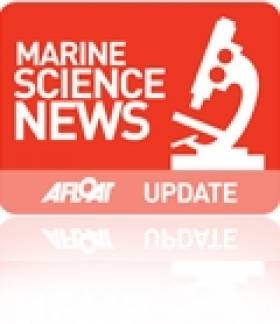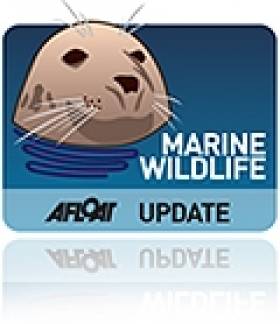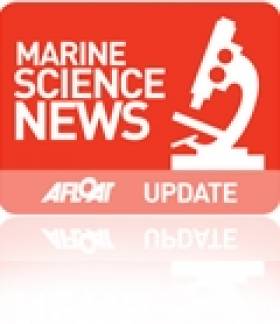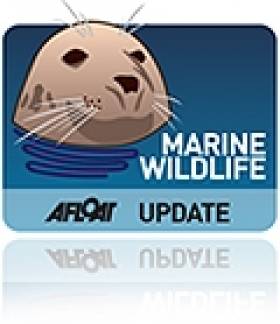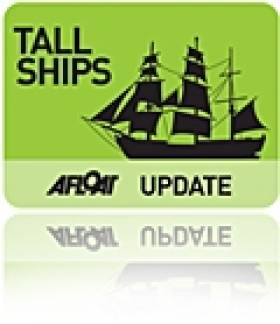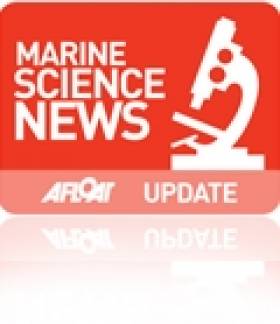Displaying items by tag: research
IWDG to Host European Cetacean Conference in Galway This March
#MARINE WILDLIFE - The Irish Whale and Dolphin Group (IWDG) will host the 26th annual European Cetacean Society Conference in Galway on the weekend of 24-25 March this year.
The Galway Bay Hotel will be the site for the main conference sessions, while workshops will also be held at the Galway-Mayo Institute of Technology (GMIT).
This year's gathering is being held under the theme 'Communication: Information and Ideas Worth Sharing'. Participants will be exploring communication between marine mammals as well as between marine scientists, and between scientists and the public.
As Ireland's Wildlife reports, the conference "offers a offers a great opportunity to find out more about whales and dolphins, their conservation, the cetacean research being carried out in Europe and to meet the researchers who are working to uncover the mysteries of these most enigmatic of creatures."
Registration is now open for the two-day event. For full details of the conference programme, venues and booking information, visit the European Cetacean Society Conference micro site HERE.
Fond Memories of Guinness Barges on the Liffey
#INLAND WATERWAYS - As Derek Evans writes in The Irish Times, the recent discovery of the first Guinness merchant vessel - sunk a century ago by a German torpedo in the Irish Sea - rekindled memories of the brewery's boats on the Liffey in the 1950s.
He writes: "Living close to Stoneybatter, I often took time to stand on Queen Street Bridge as the barges, filled with Guinness barrels, slowly made their way from James’s Gate to Sir John Rogerson’s Quay.
"I remember clearly the skipper standing beside the open wheelhouse in his navy blue polo-neck jumper, captain’s hat and pipe... The skipper always had a smile and a wave before he would disappear for a few moments under the white cloud."
He also recalls the hoisting of the barrells at Butt Bridge onto the Guinness cargo vessels - like the WM Barkley, the Lady Grania or Gwendolen Guinness - for transport to Liverpool.
As previously reported on Afloat.ie, the wreck of the WM Barkley was captured in high-resolution images taken from the national research vessel RV Celtic Voyager off the coast of Dublin.
The Irish Times has more on the story HERE.
Tips for Online Boat Buying
Canadian news website Surrey Now has some smart tips for boat buyers looking to find their latest purchase online.
It's never been easier to research the latest styles and technologies on the web, so boat buying novices can be more prepared than ever before stumping up their hard-earned euros.
Surrey Now recommends making a wish list of boats and the features you want from them to help focus your choices.
First-time buyers are also reminded to keep safety regulations in mind, and ensure their watercraft has the proper licence.
Celtic Mist Needs Funds for Refit
The Irish Whale and Dolphin Group (IWDG) has published a notice for its plans to refit the yacht Celtic Mist as a research vessel.
As previously reported on Afloat.ie, Celtic Mist was gifted to the IWDG by the Haughey family to help the group in its marine wildlife conservation work.
Under its new ownership, it completed a leg of this year's Tall Ships Race and found a new home at a sponsored berth at Kilrush, Co Clare.
Currently the IWDG is applying to the Clare Local Development Company for LEADER funding towards the refit.
IWDG co-ordinator Dr Simon Berrow said: "We are eligible for 75% funding but need to provide 25% funding ourselves. We estimate this to be in the region of €12,500.
"Celtic Mist has already cost IWDG around €5,000-7,500 so we must start a fundraising campaign to cover these and other costs."
Anyone who wishes to contribute to the fundraising campaign can contact the IWDG at [email protected]. All donations above €250 are tax deductable.
All-Ireland Whale Watch Day Next Weekend
All are invited to take part in the All-Ireland Whale Watch Day next Sunday 21 August.
The Irish Whale and Dolphin Group (IWDG) is organising 13 land-based whale watches from headlands around the Irish coast on the day from 2pm-5pm as part of the Heritage Council's annual Heritage Week.
Each will be led by experienced IWDG personnel, who will show you how to observe and identify some of the more commonly observed large marine wildlife seen in Irish waters.
The watches are free to attend - all that is required is to bring binoculars or a spotting scope, and dress appropriately for outdoor conditions.
The purpose of day is to raise awareness of the 24 species of cetaceans (porpoises, dolphins and whales) that can be seen around the Irish coast. The event will also provide IWDG researchers with a unique snapshot of whale and dolphin activity in Irish waters.
For details on your nearest whale watch visit the IWDG Whale Watch Ireland website.
Scientists Discover World of Wonder Beneath the Atlantic
The Irish-led scientific expedition aboard the RV Celtic Explorer has discovered a previously uncharted field of hydrothermal vents along the Mid-Atlantic Ridge.
As previously reported on Afloat.ie, the team includes geochemists, marine biologists, marine geologists, marine geneticists and technicians from Ireland and the UK as well as a three-person TV crew from National Geographic filming for a documentary series to be broadcast next year.
The mission, led by Dr Andy Wheeler of University College Cork, returned to Cork last Thursday from an investigation 3,000 metres below the sea surface using their Remotely Operated Vehicle (ROV) Holland 1 at the first hydrothermal vent field to be explored north of the Azores.
Hydrothermal vents, which spew mineral-rich seawater heated to boiling point by volcanic rock in the Earth’s crust below, are home to a rich variety of marine life that thrives in complete darkness on bacteria fed by chemicals.
“On the first dive, we found the edge of the vent field within two hours of arriving on the seafloor, ” said Dr Wheeler. “Often the search for vents takes much longer, and our success is a testament to the hard work and skill of everyone on board.”
The field has been named the Moytirra Vent Field, after a battlefield from Irish mythology that means ‘Plain of the Pillars’.
“In comparison with other vent fields, Moytirra contains some monstrous chimneys and is in an unusual setting at the bottom of a cliff - a real beauty,” said Patrick Collins rom NUI Galway’s Ryan Institute.
His colleague John Copley of the University of Southhampton added: “Using the ROV’s high-definition video camera, we’ve watched unusual orange-bodied shrimp crawling around the chimneys, among clusters of tiny green limpets.
“Elsewhere there are writhing scale-worms, swirling mats of bacteria and eel-like fish – a riot of life in this unlikely haven on the ocean floor.”
Speaking from the RV Celtic Explorer in Cork, Marine Minister Simon Coveney hailed the “exciting new discovery”.
“Ireland is positioning itself as a centre for marine research from a European and international perspective and this work should be supported and welcomed,” he said.
On the Trail of Fin Whales in West Cork
Ireland's Wildlife's Calvin Jones recently joined the Irish Whale and Dolphin Group on the trail of fin whales and other marine wildlife off the West Cork coast.
Following reports of sightings just off the coastline, IWDG researchers set off with group members and a ranger from the National Parks and Wildlife Service on chartered vessel the Holly Joe to confirm for themselves.
"It took a while for us to spot the characteristic blow, gracefully arching back and almost ludicrously small dorsal fin of our first fin whale," says Jones, who also notes that the calm conditions made spotting their telltale blows more difficult due to the lack of spray.
Jones continues: "This day the water was so clear that at one point, looking down from the roof of the Holly Joe, I could clearly see the whole whale – from the tip of its head to the impressive tail flukes. It was bigger than the boat by some margin: an awe inspiring sight."
Ireland's Wildlife has more on the story HERE.
The yacht once owned by the late former Taoiseach Charles Haughey will be only Irish entrant in the Tall Ships Races at Waterford later this month.
The Irish Times reports that Celtic Mist will take part in the first leg of the race to Greenock in Scotland before it is fitted out for its new life as a research vessel for the Irish Whale and Dolphin Group.
The IWDG's Simon Berrow confirmed that it has accepted the Haughey family's offer of the yacht as a gift to support its study and conservation of whales, dolphins and porpoise in Irish waters.
He said the group first had to explore the feasibility of running such a large vessel before it could accept the "very generous offer".
The Irish Times has more on the story HERE.
Celtic Mist Offered as Gift to IWDG
The yacht sailed by late former Taoiseach Charles Haughey has been offered as gift to the Irish Whale and Dolphin Group (IWDG) as a research vessel.
The Irish Times reports that 52ft Celtic Mist had been on sale in the Isle of Wight for €175,000 since last year, but with the market at a low ebb, son Conor Haughey invited the IWDG to take over the vessel, subject to negotation.
The IWDG's Simon Berrow said the group's membership showed "overwhelming support" for the gift, and is currently looking into sponsorship to support the yacht for research, as maintenance costs would run around €20,000 per year.
The Celtic Mist was once the subject of some controversy when it emerged during the Moriarty Tribunal that businessman Dermot Desmond had paid refurbishment costs of €75,000, a sum that exceeded Haughey's then salary as Taoiseach.
'The Sea: One of Ireland's Greatest Natural Resources' - Coveney
The Minister was speaking during a visit to the Marine Institute's research vessel, RV Celtic Explorer, on its return from a mission to the Labrador and Newfoundland Seas.
He added "I am particularly pleased that this is my first official engagement as Minister for Agriculture, Marine and Food. The work of the RV Celtic Explorer highlights the essential nature of marine research, development and sustainable management, through which Ireland is developing a strong and well-deserved reputation as an emerging centre of excellence, where we have prominent roles in many European and international marine science bodies."
Minister Coveney commended the Marine Institute and its Chief Executive, Dr Peter Heffernan, for its leading and proactive role in the areas of fisheries science, marine environment and food safety as well as ocean science and said that he looked forward to working closely with the Institute and benefitting from the research and advice which they would undertake and provide.
The Minister noted that Ireland's two national research vessels – RV Celtic Explorer and RV Celtic Voyager – will record 267 days at sea during 2011, during which they will be engaged in fisheries surveys, underwater mapping, climate studies and deepwater surveys.





























